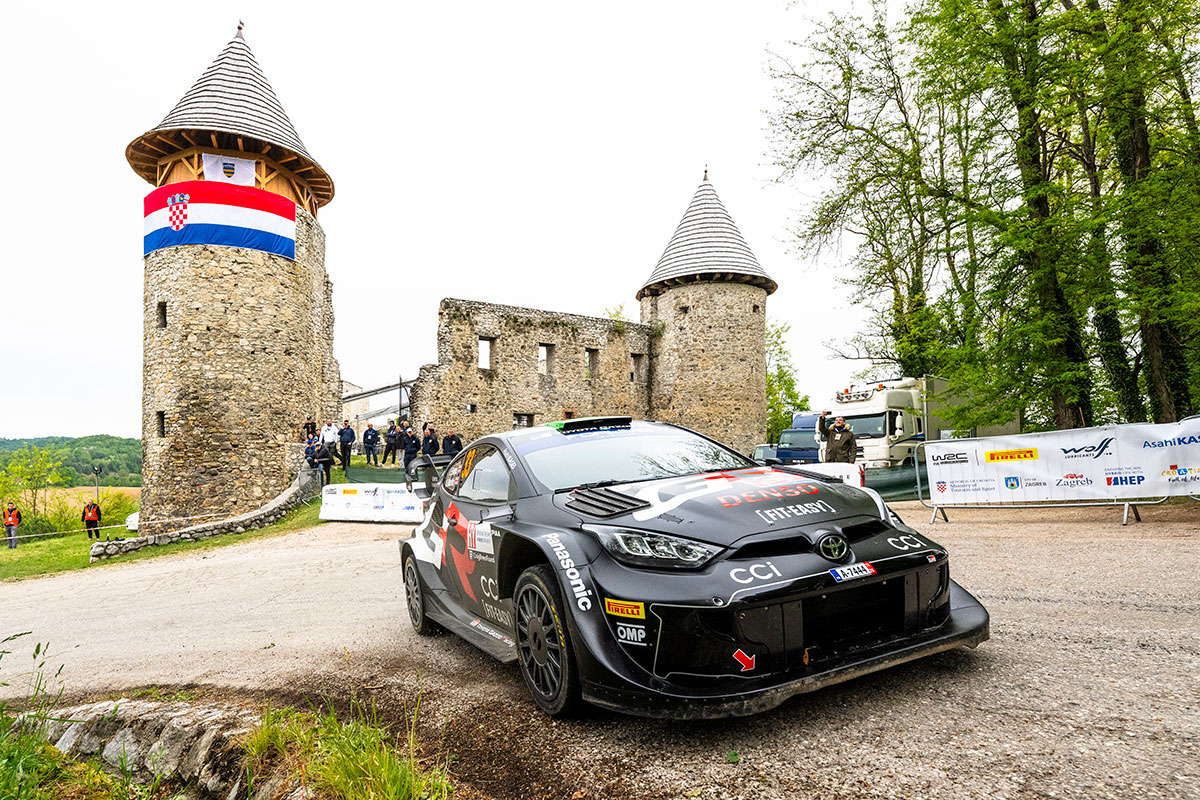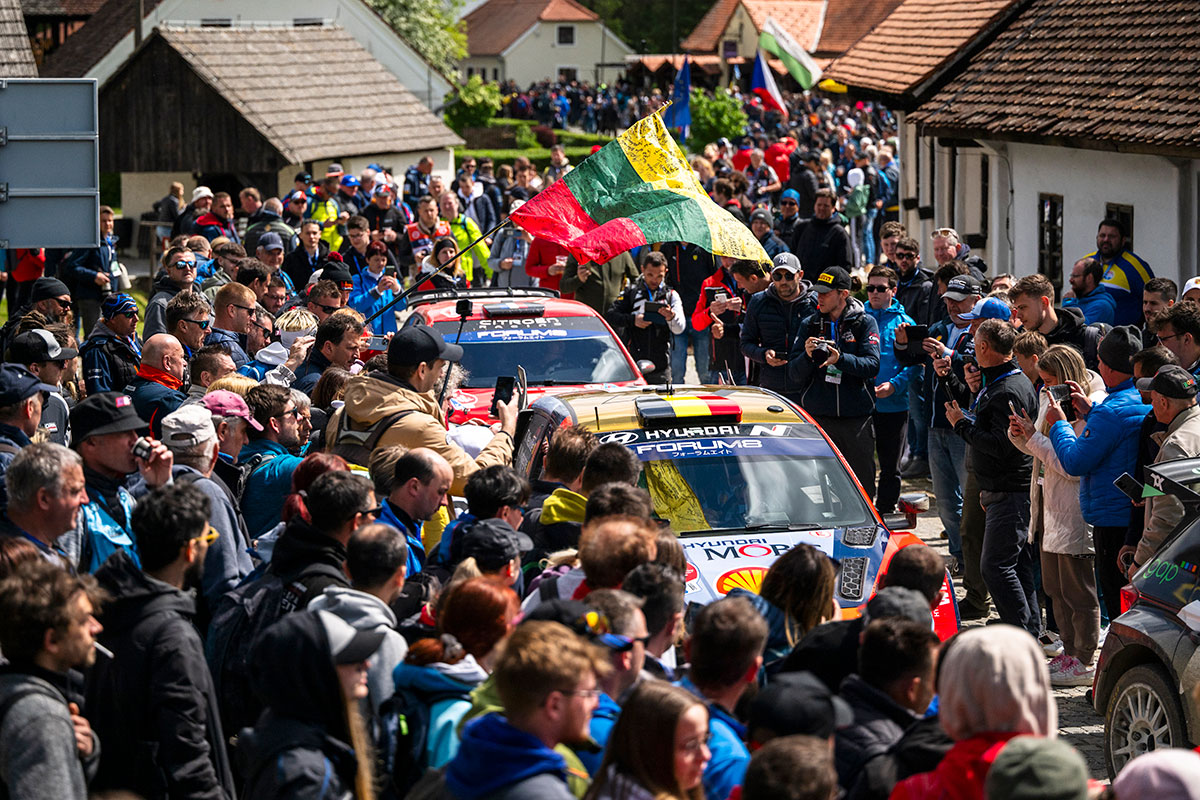But then it exploded on the final morning as both Thierry Neuville and Elfyn Evans blinked on the very same stage, paving the way clear for Sebastien Ogier to sneak through and take the 100th World Rally Championship podium of his career. Incredibly, 59 of those have been victories.
With the dust now settling on round four of 2024’s global rallying tour, here are RallySport Magazine’s five big takeaways from Zagreb’s Tarmac thriller.
Croatia keeps delivering
In the four years the WRC has visited Croatia, only once has the leaderboard not turned on its head on the final day. There must be something in the waters in Europe’s south-east.
Back in 2021, Ogier famously collided with a traffic car on the way to Sunday morning’s first stage which damaged his Toyota, and team-mate Evans looked to have capitalised until he made a hash of the rally’s very last corner and ended up losing the rally by 0.6 seconds – still to this day the closest WRC finish on asphalt.
The following year, Kalle Rovanpera looked to have the event sewn up until the heavens opened, and Hyundai’s Ott Tanak surged in front with wet tyres bolted on his i20. But then Rovanpera responded in inspired fashion, destroying Tanak in a breathless Power Stage performance that not only earned him a third win on the bounce but effectively the championship title.
This year, championship challengers Neuville and Evans wouldn’t leave each other alone – sharing the lead at the end of Friday and trading it throughout the whole of Saturday. An on-the-edge Ogier was trying his best to get involved but menacingly lurked within 12s of the lead heading into the final day.
In the end, after Evans spun and Neuville headed off the road – an excursion he put down to a late pace note – Ogier secured victory by 9.7s over Evans. It was the first time the lead of a WRC event changed hands on the final day since Croatia 2022.
The undulating roads and slippery conditions clearly create a challenge and continually produce a brilliant sporting spectacle. It’s hard not to feel that Croatia is becoming a modern classic in the WRC.
Points discussion only intensifies
Ironically, there was actually the least discussion about the WRC’s new-for-2024 points system after the very first round it was implemented – but that’s probably because Neuville won the rally and the most points from the weekend in Monte Carlo.
Since, social media has been awash with dismayed fans at the conclusion of WRC Sundays, and that debate only got stronger after Croatia. Several of the key players aren’t exactly fond of it either: Evans told Autosport he got “zero reward” for finishing second, and Ogier declared himself glad to not be a full-time contender to Rally Journal, labelling the points system “unbelievably wrong”.
To recap, points are now awarded to the top 10 after Saturday (but only if they finish Sunday), while ‘Super Sunday’ now rewards the fastest seven drivers on the final day, with the Power Stage remaining the same as last year, with bonus points to the quickest five on that particular stage.
The net result is the rally classification doesn’t mirror the rankings of who scored the most championship points on the weekend. Rally Sweden winner Esapekka Lappi was outscored by second place Evans, in Kenya Neuville was the second-highest scorer despite finishing fifth overall, and in Croatia Tanak wasn’t a feature in the fight at the front, yet outscored both Neuville and Evans who finished ahead of him.
Any serious change is unlikely to come mid-season as that would significantly alter the complexion of the way this championship will be won, but calls for the FIA to make a change certainly aren’t quietening down. As much as this new system has achieved its primary objective of livening up Sundays, at the moment it seems to be a case of fixing one problem but creating another.

Mikkelsen’s still not up to Rally1 speed
Andreas Mikkelsen is much better than his drive to sixth place last weekend made him look. You need only look as recently as that swashbuckling run to the WRC2 title last year as proof.
But, unfortunately, the Norwegian has been disappointing in his two Rally1 starts so far in 2024 upon his Hyundai return. Adapting to the hike in power and hybrid strategy, plus the more aggressive aero compared to Rally2, which Mikkelsen had mastered, proved an understandable challenge in Monte Carlo, but Mikkelsen would’ve hoped to show more than he did in Croatia.
Monte Carlo was three months ago, but he had benefited from some extra running on Italy’s Rally Regione Piemonte the weekend before. That led to some rather bullish talk of a potential WRC podium in Croatia, but it just didn’t happen.
An overshoot on the very first stage typified a weekend where Mikkelsen struggled to get on top of the car. Out of 20 stages, he only managed three top-five times and finished four minutes down on rally winner Ogier.
Sharing a seat with Lappi and Dani Sordo, Mikkelsen has effectively been badged as Hyundai’s asphalt expert this season – which always seemed fairly ironic given Mikkelsen’s chief struggles with Hyundai the first time around were on Tarmac.
We aren’t privy to Hyundai’s driver strategy, so beyond confirmation that Sordo will be in for Portugal (and probably Sardinia), and then the expectation Lappi will get a run on the three high-speed events in Poland, Latvia and Finland, we don’t know when Mikkelsen will return. But it would be interesting to see him compete on gravel, to understand where specifically his current struggles lie.

Citroen’s rivals got their tactics right
Perhaps it wasn’t the one that most expected to win, but there was little doubt that a Citroen C3 Rally2 was going to win WRC2 in Croatia. Mads Ostberg’s 2021 victory and Yohan Rossel’s double in 2022 and ’23 meant Citroen had never been beaten to the top spot in Zagreb, and Nikolay Gryazin ensured that run continued with his first WRC2 victory in the French machine.
That’s the bit that was less expected – the fact Gryazin was so comfortably clear of Rossel, who’s become the asphalt benchmark in WRC2.
Either way, Citroen’s dominance of Croatia Rally would not have been lost on its main WRC2 title rivals. So while Citroen was left to celebrate the perfect 1-2 result, Skoda’s Oliver Solberg and Gus Greensmith, as well as Toyota pilot Sami Pajari, had plenty of reason to smile too as they successfully avoided a championship drubbing.
Ironically, Pajari and Greensmith actually had an entertaining battle of their own for third in class – Pajari coming out on top by a slender 0.3s – but their defeat to Gryazin and Rossel was essentially meaningless as they hadn’t nominated Croatia as one of their seven points-scoring rounds.
Solberg didn’t even compete in Croatia and is perhaps the biggest tactical winner. Last year he wanted to take on as many drivers as he could to prove he was the best. This year he realised that’s not necessarily the most effective route to the championship, and sitting at home while Gryazin and Rossel racked in the points was the best way to prove that.

Jurgenson’s the real deal
If Rally Sweden didn’t show it, Croatia certainly did. The FIA Rally Star programme has unearthed some serious driving talents, and Romet Jurgenson looks to be a real star of that bunch.
His performance was sublime in Croatia. Ali Turkkan may have led after the first two stages, but Jurgenson was the only one to stay in touch. So when the Turk crashed his Ford Fiesta Rally3 on SS3, Jurgenson suddenly found himself almost 50 seconds out front and he drove the perfect rally thereafter to get the job done.
Off the back of a second-place finish in Sweden, the Estonian now leads the Junior WRC standings by an impressive 22 points. And that’s against a field of 19 other drivers, lest we forget.
A guaranteed champion? Not quite. But a certified contender? Absolutely.
And if any further proof was needed about the quality of the drivers FIA Rally Star has unearthed, Australia’s Taylor Gill was a standout second to Jurgenson in Croatia and finds himself third in the championship as a result.
With his epic speed in Sweden, he too has marked himself out as a real star of the future.





